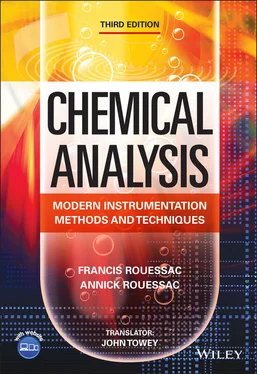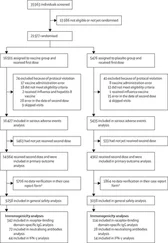6 One peak = one compound is the ideal situation. At column outlet, we treat the ideal peak as a Gaussian peak (hence the parameters σ, δ, ω), but the reality may be different. An ideal chromatogram has peaks that do not overlap and which are at least somewhat spaced out. A peak alone does not enable the absolute identification of a compound.
7 A number of parameters can be used to better characterize each separation: efficiency, retention, separation, and resolution. The flow rate of the mobile phase has an influence on efficiency. Many empirical equations, not reported in this chapter, are offered to mathematically define the behaviour of analytes during elutions with a gradient.
8 The speed of progression of the mobile phase with respect to the stationary phase has an essential influence on separation quality. A hyperbolic function, formed from the addition of three independent terms, known as the Van Deemter equation, demonstrates the existence of an optimal linear speed, i.e. leading to a minimum value of HETP.
9 First established for GC, and later adapted to HPLC, the three terms of the previous equation refer to preferential paths (turbulent diffusion), to longitudinal diffusion, and to resistance to mass transfer.
10 The quantification of analytes using chromatography is founded on the relationship between the mass and the area of the corresponding peak on the chromatogram. There are three methods, called the external standard method, internal standard method, and internal normalization method. The first is by far the most used because it is the quickest when it comes to processing a large number of analyses. Chromatograms equipped with a sample holder carousel and an automatic injection device make this method very reliable.
1 For a given solute, show that the analysis time (which we can assume is equal to the retention time of the most retained compound) depends, amongst other things, on the column length L, on the average linear speed ū of the mobile phase, and on volumes VS and VM, which respectively designate the volume of the stationary phase and the volume of the mobile phase.
2 Calculate the separation factor (or selectivity factor) between two compounds, 1 and 2, whose retention volumes are 6 ml and 7 ml, respectively. The dead volume of the column is 1 ml. Show that this factor is equal to the ratio of the distribution coefficients K2/K1 of these compounds (tR(1) < tR(2)).
3 Equation (P1.2) is sometimes employed to calculate Neff. Show that this relation is equivalent to the more classical Eq. (P1.1): (P1.1) (P1.2)
4 The resolution factor R for two solutes 1 and 2, whose elution peaks are adjacent, is sometimes expressed by Eq. (P1.3): (P1.3) (P1.4)If it is assumed that the two adjacent peaks have the same width at the baseline (ω1 = ω2), then show that Eq. (P1.4) is equivalent to Eq. (P1.3) for resolution.The effective plate number Neff may be calculated as a function of the separation factor α for a given value of the resolution, R. Derive this relationship.
5 Show that if the number of theoretical plates N is the same for two neighbouring compounds 1 and 2, then the classical expression is thus: (P1.5)Then show that if Eqs. (P1.5) and (P1.6) are equivalent: (P1.6)
6 The characteristics of a C‐18 column, offered by a manufacturer for ultra‐rapid HPLC, are:Length: 50 mm, diameter: 2 mm, particle diameter: 2 μm. The test chromatogram accompanying the column shows six well‐spaced peaks in less than 2 min.Solute No.012345tR (min)0.210.310.420.761.141.58On the chromatography report, the following information can also be found:For solute No. 5: N = 106,000 plates per metre; asymmetry at 10% of height A = 1.07. Remember that for an asymmetrical peak, the number of theoretical plates N is calculated from the following equation: and that For peak No. 5, calculate width ω0.1 measured at 10% of its height (from the baseline) and values a and b.Knowing that peak No. 0 corresponds to a nonretained solute, calculate for solutes 4 and 5, the retention factors k4 and k5, the separation factor α, and the resolution R between these two peaks. Assume that the efficiency N is the same for these two solutes, i.e. the value given by the manufacturer.Knowing that the phase ratio for such a column may be expressed as: where SA is the specific area of the material contained in the column and SV is the specific volume of the pores, calculate the phase ratio in the case where SA = 330 m2 g‐1 and SV = 1 ml g‐1 (units adapted to the direct application of the relationship giving β).Comment. The factor 0.6 corresponds to the column’s packing rate with silica and 0.45 corresponds to the silica volume in ml for 1 gram.Knowing the phase ratio, calculate, for solutes 4 and 5, the Nernst distribution factor. Do these two values correspond to the elution order obtained?
7 Using the internal normalization method, we want to determine the mass composition of a sample made of four butyric esters. A reference solution of these four esters (with known mass concentrations) leads to the following relative response factors for methyl ester (ME), ethyl ester (EE), and propyl ester (PE) as compared to butyl ester (BE): From the information provided by the chromatogram of the sample being assayed, find the mass composition of this mixture.Peak No.tR CompoundArea (arbitrary units)12.54Methyl ester (ME)2,340.123.47Ethyl ester (EE)2,359.035.57Propyl ester (PE)4,077.347.34Butyl ester (BE)4,320.7
8 Assay of serotonin S (5‐hydroxytryptamine) using the internal standard method.We sample 1 ml of the solution to assay, to which we add 1 ml of a solution containing 3 ng of N‐methylserotonin (NMS). We treat this mixture to remove all other intrusive compounds from it. We perform solid‐phase extraction to isolate serotonin and its methyl derivative, diluted in a suitable phase.Why do we add the internal standard compound before the extraction stage?Calculate the response factor of serotonin with respect to N‐methylserotonin, knowing that the calibration chromatogram leads to the following results:‐ serotonin area30,885,982 μV squantity injected: 5 ng‐ N‐methylserotonin area30,956,727 μV squantity injected: 5 ngBased on the chromatogram of the sample solution, find what the serotonin concentration is in the starting sample, knowing that the serotonin peak area is equal to 2,573,832 μV s and the N‐methylserotonin peak area is 1,719,818 μV s.
1 We have tR = tM(1+k). And tM = L/ū and k = KVS/VM, hence tR = (L/ū)(1+KVS/VM).
2 Knowing that VR = tR∙D, we get: α = (VR(2) – VM)/(VR(1) ‐ VM), i.e. α = 1.2.
3 To transform Eq. (P1.1) into Eq. (P1.2), we add k, from tM = tR/(1+k).
4 When peaks are neighbours, base widths are generally comparable. By posing ω1 = ω2 and by expressing ω2 with its value as a function of N2, we obtain R = ¼ √N2 (tR(2) – tR(1))/tR(2). Then, we add k, by using tR = tM(1 + k); finally, we introduce α = k2/k1;The relationship given in the problem is obtained by rearranging the relationship for R (as a function of k and α) and substituting the relationship for Neff from Eq. (P1.2) of problem 1.3.
5 From the base relationship R = 2(tR(2) – tR(1))/(ω1 + ω2), we can replace ω with its value depending on N, ω = 4tR /√N and since tR = tM(1 + k), we obtain Eq. (P1.5);We multiply the second member of (1), numerator and denominator by (k1 + k2) and we obtain α (α = k2/k1).
6 ω0.1 = a + b = 2A ∙ a; A = (a + b)/2a => b = a(2A − 1) => a/b = 1/(2A − 1) => where N = 53,000 plates, tR = 1.58 min and A = 1.07, and thus we get:a = 0.0142 min.b = 0.0162 min.ω0.1 = 0.0304 min.k = (tR − tM)/ tMtherefore, k4 = 4.43 and k5 = 6.62; α4‐5 = k5 /k4 = 1.47; (this assumes that the peak is Gaussian)β = 136.6;K = k β; K4 = 605 and K5 = 884; K5 > K4 means that solute 5 has more affinity for the stationary phase than solute 4; therefore, it is more retained and exits later.
Читать дальше




![Евгений Матерёв - Музеи… или вдохновляющая музыка The Chemical Brothers [litres самиздат]](/books/437288/evgenij-materev-muzei-ili-vdohnovlyayuchaya-muzyka-th-thumb.webp)







